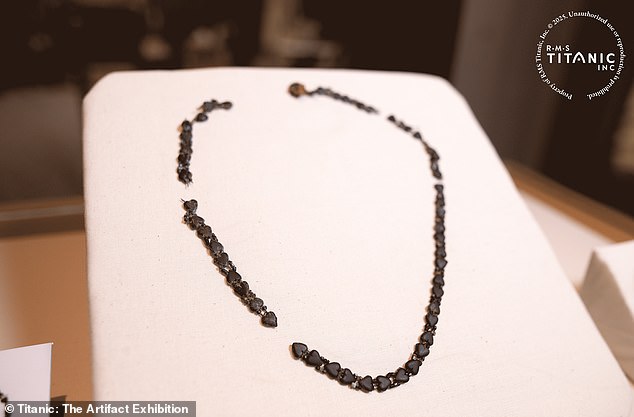
Titanic Shipwreck Yields Century-Old Black Glass Necklace Lost for Decades in Ocean Depths
Rare Black Glass Necklace Recovered from Titanic Wreck Reveals Untold Stories
A delicate black glass necklace, recovered from the wreck of the RMS Titanic, offers a haunting connection to the 1,517 lives lost in the 1912 disaster. Discovered in fragments during a 2000 expedition, the artifact—featuring intricate heart-shaped and octagonal beads—is one of the rarest items salvaged from the site. Experts believe it may have been a cherished keepsake, carried by a passenger or crew member during the ship’s tragic maiden voyage.
[Image 1: The Black Glass Necklace on display at The Artifact Exhibition Orlando]
Recovery and Conservation
The necklace was found scattered across a 15-square-mile debris field near the ship’s bow and stern, fused into a hardened mass called a “concretion” from decades under 12,500 feet of ocean pressure. “Bead after bead led to another. It speaks to human perseverance,” said Tomasina Ray of RMS Titanic Inc, the only company authorized to retrieve Titanic artifacts. Painstakingly restored over 25 years, the necklace now symbolizes both craftsmanship and loss.
[Image 2: Necklace fragments extracted from seafloor concretion]
A Link to 1912 Life
The design reflects early 20th-century fashion and mourning customs. Black jewelry, often made from materials like French jet, symbolized grief during the Victorian era. While its owner remains unknown, the necklace might have belonged to a victim or a survivor separated from it during the chaos. “It offers a glimpse into Titanic’s passengers’ lives,” Ray noted, emphasizing how personal items humanize the disaster.
Exhibition and Legacy
Now displayed at Titanic: The Artifact Exhibition in Orlando, Florida, the necklace joins 300+ artifacts, including a two-ton hull section called “Little Piece.” The exhibit recreates Titanic’s grandeur through interactive displays and costumed actors, preserving stories of those aboard. RMS Titanic Inc has recovered over 5,500 artifacts since 1987, each conserved to honor the tragedy’s legacy.
[Image 3: 3D scan showing Titanic’s bow, rusted but still recognizable]
Titanic’s Fate
The ship, which sank on April 15, 1912, after hitting an iceberg, now lies in two main pieces 2,600 feet apart on the Atlantic floor. The bow remains partly intact, while the stern is a crumpled metal heap. A debris field of personal items—shoes, champagne bottles, and furniture—surrounds the wreck. Despite its deterioration, ongoing expeditions continue uncovering artifacts, though experts warn the ship will eventually vanish due to natural decay.
[Image 4: Titanic’s stern, a twisted wreckage]
Conclusion
The black glass necklace stands as a poignant reminder of lives intertwined with history. As Titanic’s remains fade, discoveries like this ensure its passengers’ stories endure. “Every artifact reflects a commitment to honoring those lost,” RMS Titanic Inc stated—a testament to resilience amid tragedy.
Titanic: Key Facts
- Maiden Voyage: Sank April 15, 1912, four days after departing Southampton.
- Victims: Over 1,500 died; many wealthy passengers, including John Jacob Astor IV and Isidor Straus.
- Discovery: Found in 1985, 73 years after sinking.
- Legacy: Artifacts like the necklace preserve personal narratives from the “unsinkable” ship’s fateful journey.
[Image 5: Titanic departing Southampton on April 10, 1912]
(Word count: ~600)


